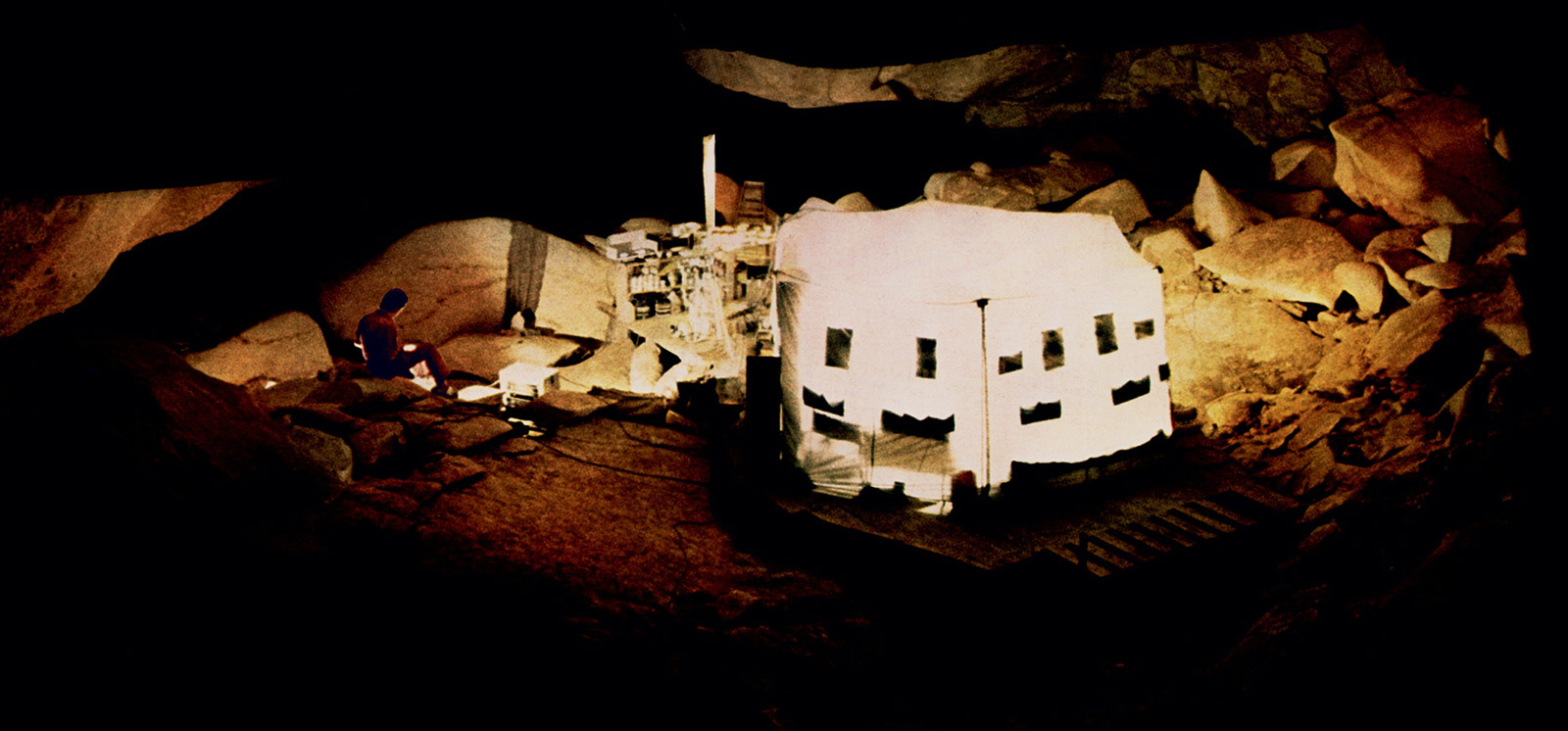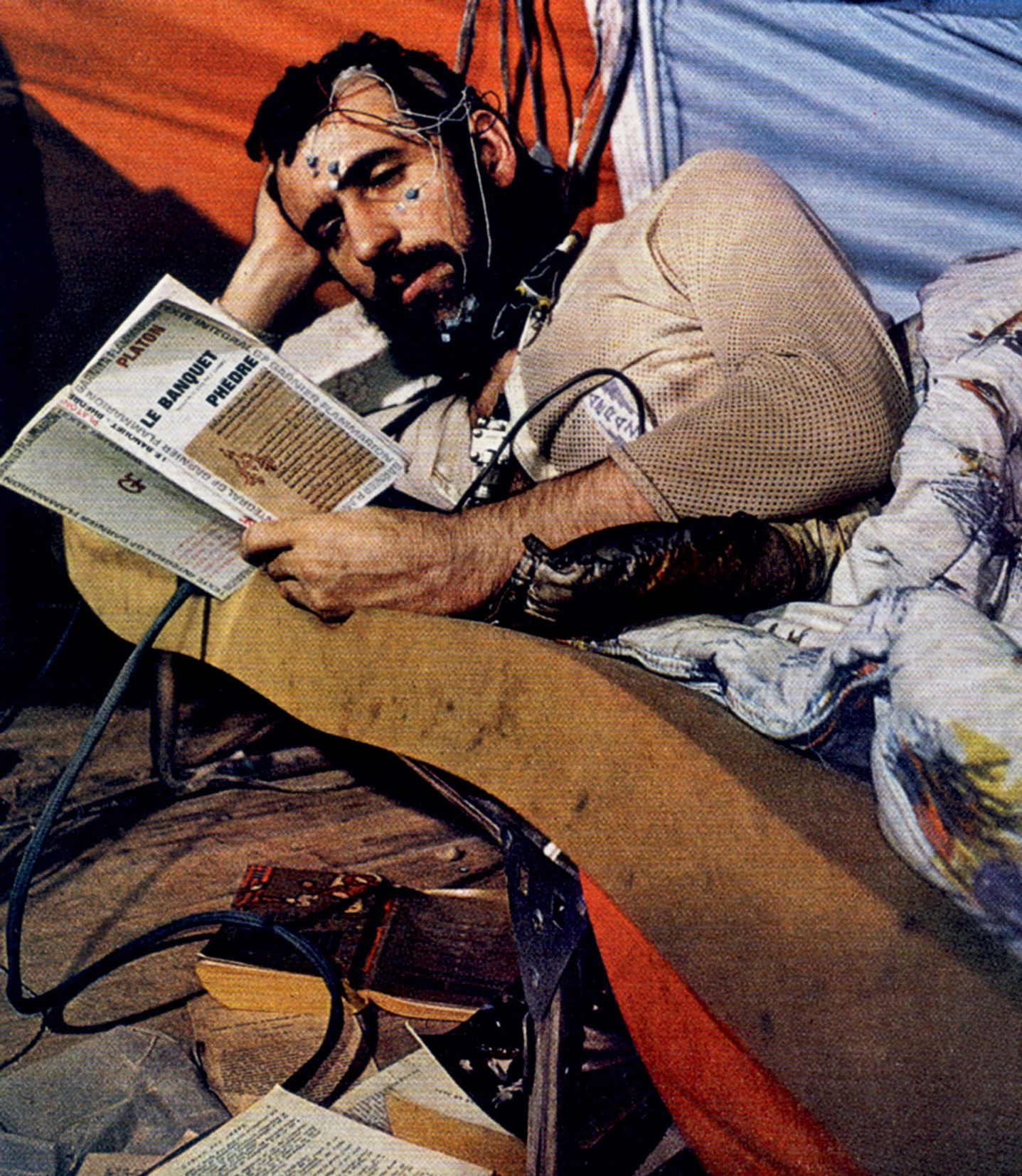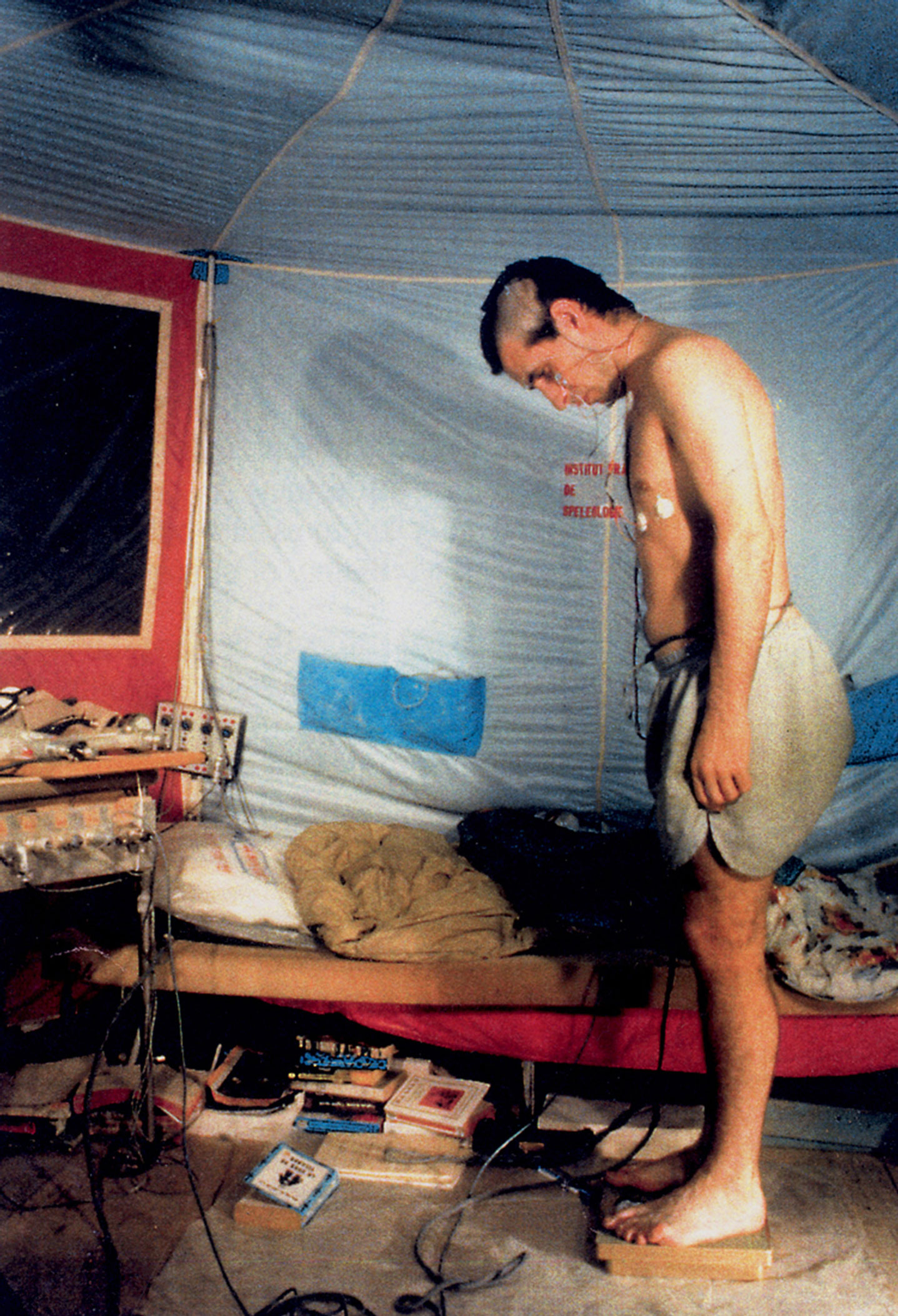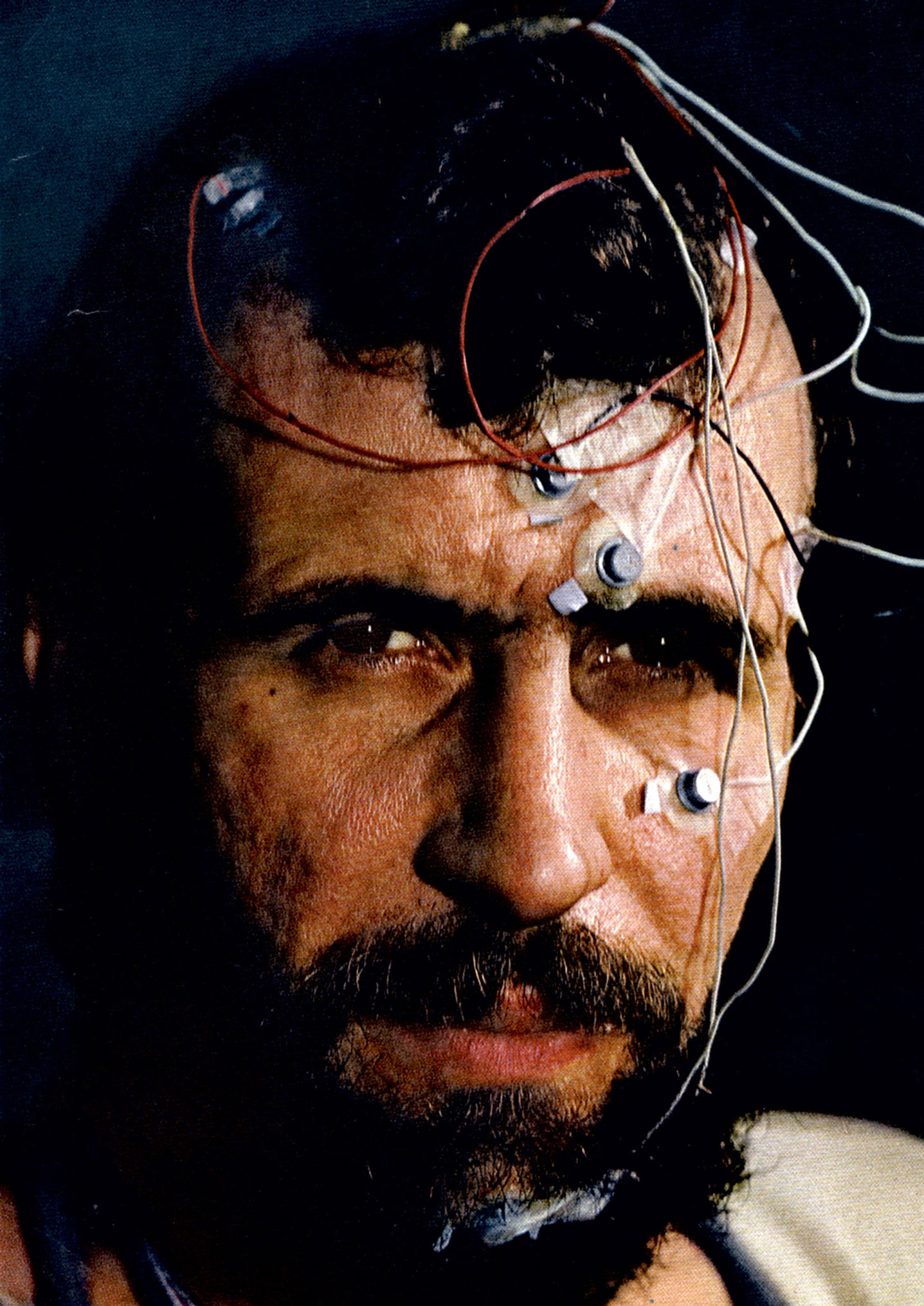Caveman: An Interview with Michel Siffre
Living beyond time
Joshua Foer and Michel Siffre

In 1962, a French speleologist named Michel Siffre spent two months living in total isolation in a subterranean cave, without access to clock, calendar, or sun. Sleeping and eating only when his body told him to, his goal was to discover how the natural rhythms of human life would be affected by living “beyond time.” Over the next decade, Siffre organized over a dozen other underground time isolation experiments, before he himself returned to a cave in Texas in 1972 for a six-month spell. His work helped found the field of human chronobiology. Joshua Foer interviewed Siffre by email.
Joshua Foer: In 1962, you were just twenty-three years old. What made you decide to live underground in complete isolation for sixty-three days?
Michel Siffre: You have to understand, I was a geologist by training. In 1961, we discovered an underground glacier in the Alps, about seventy kilometers from Nice. At first, my idea was to prepare a geological expedition, and to spend about fifteen days underground studying the glacier, but a couple of months later, I said to myself, “Well, fifteen days is not enough. I shall see nothing.” So, I decided to stay two months. And then this idea came to me—this idea that became the idea of my life. I decided to live like an animal, without a watch, in the dark, without knowing the time.
Instead of studying caves, you ended up studying time.
Yes, I invented a simple scientific protocol. I put a team at the entrance of the cave. I decided I would call them when I woke up, when I ate, and just before I went to sleep. My team didn’t have the right to call me, so that I wouldn’t have any idea what time it was on the outside. Without knowing it, I had created the field of human chronobiology. Long before, in 1922, it had been discovered that rats have an internal biological clock. My experiment showed that humans, like lower mammals, have a body clock as well.

During your first stay underground, temperatures were below freezing, and humidity was ninety-eight percent. How did you pass the time?
I had bad equipment, and just a small camp with a lot of things cramped inside. My feet were always wet, and my body temperature got as low as 34°C (93°F). My pastimes were reading, writing, and doing research in the cave. I also spent a lot of time thinking about my future. Also, there were two tests I performed every time I called the surface. First, I took my pulse. Secondly, there was a psychological test. I had to count from 1 to 120, at the rate of one digit per second. With that test we made a great discovery: it took me five minutes to count to 120. In other words, I psychologically experienced five real minutes as though they were two.
The psychologist Elizabeth Loftus conducted an experiment in which she showed people a filmed scene of a bank robbery and asked them to estimate its duration. They overestimated by 500 percent. It seems that our subjective experience of time is highly variable. In the absence of clocks, how did you feel time’s passage?
There was a very large perturbation in my sense of time. I descended into the cave on July 16 and was planning finish the experiment on September 14. When my surface team notified me that the day had finally arrived, I thought that it was only August 20. I believed I still had another month to spend in the cave. My psychological time had compressed by a factor of two.
What do you think caused this dramatic disconnect between psychological time and the clock?
That’s a big question that I’ve been investigating for forty years. I believe that when you are surrounded by night—the cave was completely dark, with just a light bulb—your memory does not capture the time. You forget. After one or two days, you don’t remember what you have done a day or two before. The only things that change are when you wake up and when you go to bed. Besides that, it’s entirely black. It’s like one long day.

These sorts of isolation experiments could just as easily be carried out in a laboratory. Why have you always preferred to do them underground?
A laboratory is a fine place to do these experiments, but you must find people who are motivated. It’s difficult to ask people to spend several months in a laboratory capsule. During the period between 1962 and 1972, a professor in Germany did more than 150 isolation experiments in an artificial underground bunker, but they were short-term experiments, lasting only about a month. The people we sent underground were spelunkers first, and so they were interested in the caves and could stay longer because of their high motivation.
When you were underground, entirely isolated from any artificial measurements of time, your body slept exactly when it wanted to, and for exactly as long as it wanted to. It might be said that you achieved perfect sleep. What was that like?
My sleep was perfect! My body chose by itself when to sleep and when to eat. That’s very important. We showed that my sleep/wake cycle was not twenty-four hours, like people have on the surface on the earth, but slightly longer—about twenty-four hours and thirty minutes. But the important thing is that we proved that there was an internal clock independent of the natural terrestrial day/night cycle. Interestingly, during the subsequent experiments I did with other research subjects, all of the people in the caves showed cycles longer than twenty-four hours. In fact, it became common for them to achieve cycles lasting forty-eight hours: They would have thirty-six hours of continuous activity followed by twelve to fourteen hours of sleep. After we made that discovery, the French army gave me lots of funding. They wanted me to analyze how it would be possible for a soldier to double his wakeful activity.
What did you find?
After me, I put a man in a cave for four months, and then a woman for three months. In 1966, another man did six months underground, and then we did two other experiments lasting four months. We analyzed sleep stages—the rapid eye movement (REM) stage, when dreaming occurs, and slow-wave sleep—and we made another discovery. We showed that there is a correlation between how long a person stays up and how much he dreams the next night. Roughly speaking, for every ten extra minutes of activity each day, a man gets one extra minute of REM sleep. We also found that the more you dream, the shorter your reaction time during your next phase of wakefulness. After we made this discovery, the French army tried to find drugs that artificially increase the amount of time spent dreaming, with the hope of producing very long days of thirty or more hours for soldiers.
Ten years after your first time-isolation experiment, you went back underground yourself, this time in Midnight Cave near Del Rio, Texas, and spent 205 days. Why did you go back?
There were two reasons. First, I was interested in studying the effects of aging on psychological time. My plan was to do an experiment every ten or fifteen years to see if there had been any changes in how my brain perceives time. Secondly, all of the other people I had put underground caught a forty-eight-hour sleep/wake cycle, except for me. I decided I would stay underground for six months to try to catch the forty-eight-hour cycle.
Why do people fall into this forty-eight-hour cycle?
I have no theory. I don’t make theories. The forty-eight-hour cycle is a fact. I observed this phenomenon, and I’m sure of this finding, but nobody understands what could be responsible for such a large desynchronization of the sleep-wake cycle. And now that the Cold War is finished, it’s more difficult to get funding. Today, only mathematicians and physiologists can go further with this.

Your first subterranean isolation experiment took place in 1962, the same year that the Cuban Missile Crisis made the world starkly aware of the importance of bomb shelters, and a year after Yuri Gagarin first entered space. How did those two events change the way we think about the underground?
I came at the right time. It was the Cold War, and we knew nothing about the human sleep cycle in outer space. Not only was there a competition between the US and Russia to put men into space, but France had also just begun its nuclear submarine program. French headquarters knew nothing about how best to organize the sleep cycle of submariners. This is probably why I received so much financial support. NASA analyzed my first experiment in 1962 and put up the money to do sophisticated mathematical analysis.
What is it about the underground that both attracts us and scares us?
It is dark. You need a light. And if your light goes out, you’re dead. In the Middle Ages, caves were the place where demons lived. But at the same time, caves are a place of hope. We go into them to find minerals and treasures, and it’s one of the last places where it is still possible to have adventures and make new discoveries.
You rang in the new millennium 2,970 feet below ground in the Clamouse Cave with foie gras and champagne, but you were three-and-a-half days late. You also missed your sixty-first birthday. Why did it take almost three decades for you to decide to go underground again?
When I came out of Midnight Cave in 1972, I was 100,000 US dollars in debt. I had badly underestimated the cost of bringing my experiments from France to Texas, and I had to leave the field of chronobiology. Much of my data from that experiment has yet to be mathematically analyzed. In 1999, I decided to go back into a cave in the south of France. I stayed there for two months, studying the effects of aging on the circadian cycle. I was following the lead of John Glenn, who went back into space at age seventy-seven.
I understand you’re at work on a “permanent subterranean station for human confinement and chronobiology experiments.” What else are you working on?
The experiments in the caves are finished. You can’t do these kinds of experiments any more. When we first did them, I was young, and we took all the risk. Now, there are limitations on researchers. Now you have ethics panels. Let me give you an example. In 1964, the second man after me to go underground had a microphone attached to his head. One day he slept thirty-three hours, and we weren’t sure if he was dead. It was the first time we’d ever seen a man sleep for that long. I thought, okay, I’ll descend into the cave and find out what happened. And then at thirty-four hours, he snored, and we understood he was alive. And then a couple minutes later, he called us at the surface to take his pulse. Today, doctors would have to wake him up because it would be too risky to do otherwise.
Did you ever succeed in catching a forty-eight-hour cycle?
Yes. In the 1972 experience in Texas, there were two periods where I caught the forty-eight-hour cycle—but not regularly. I would have thirty-six hours of continuous wakefulness, followed by twelve hours of sleep. I couldn’t tell the difference between these long days and the days that lasted just twenty-four hours. I studied the diary I kept in the cave, looking cycle by cycle, but there was no evidence that I perceived those days any differently. Sometimes I would sleep two hours or eighteen hours, and I couldn’t tell the difference. That is an experience I think we all can appreciate. It’s the problem of psychological time. It’s the problem of humans. What is time? We don’t know.
See press about “Caveman: An Interview with Michel Siffre” in Mother Nature Network.
Michel Siffre is a scientist based in Paris. He is the author of several books, including Beyond Time (McGraw-Hill, 1964) and Découvertes dans les grottes mayas (Arthaud, 1993).
Joshua Foer is a freelance science writer. He is working on a book about the art and science of memory, forthcoming from Penguin.